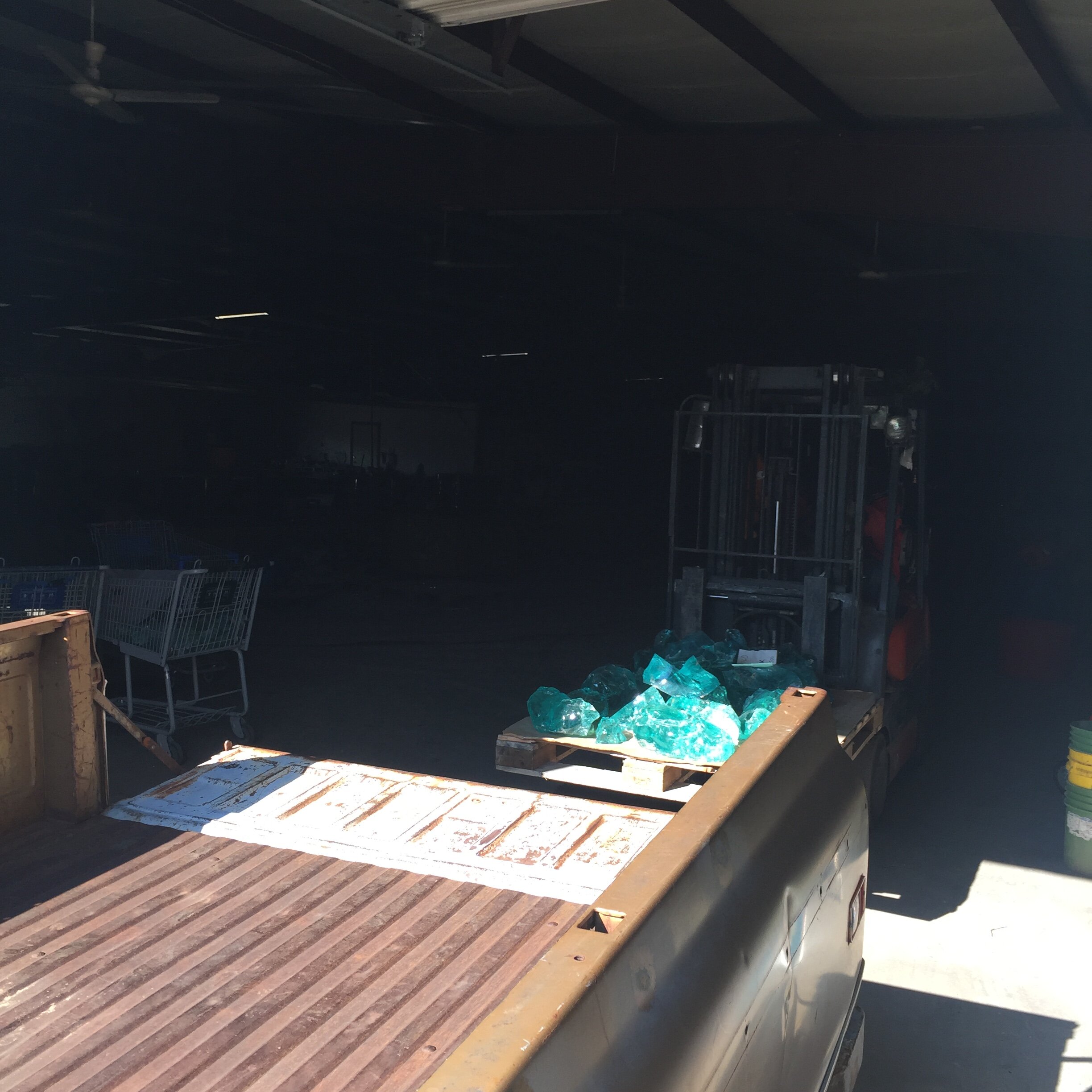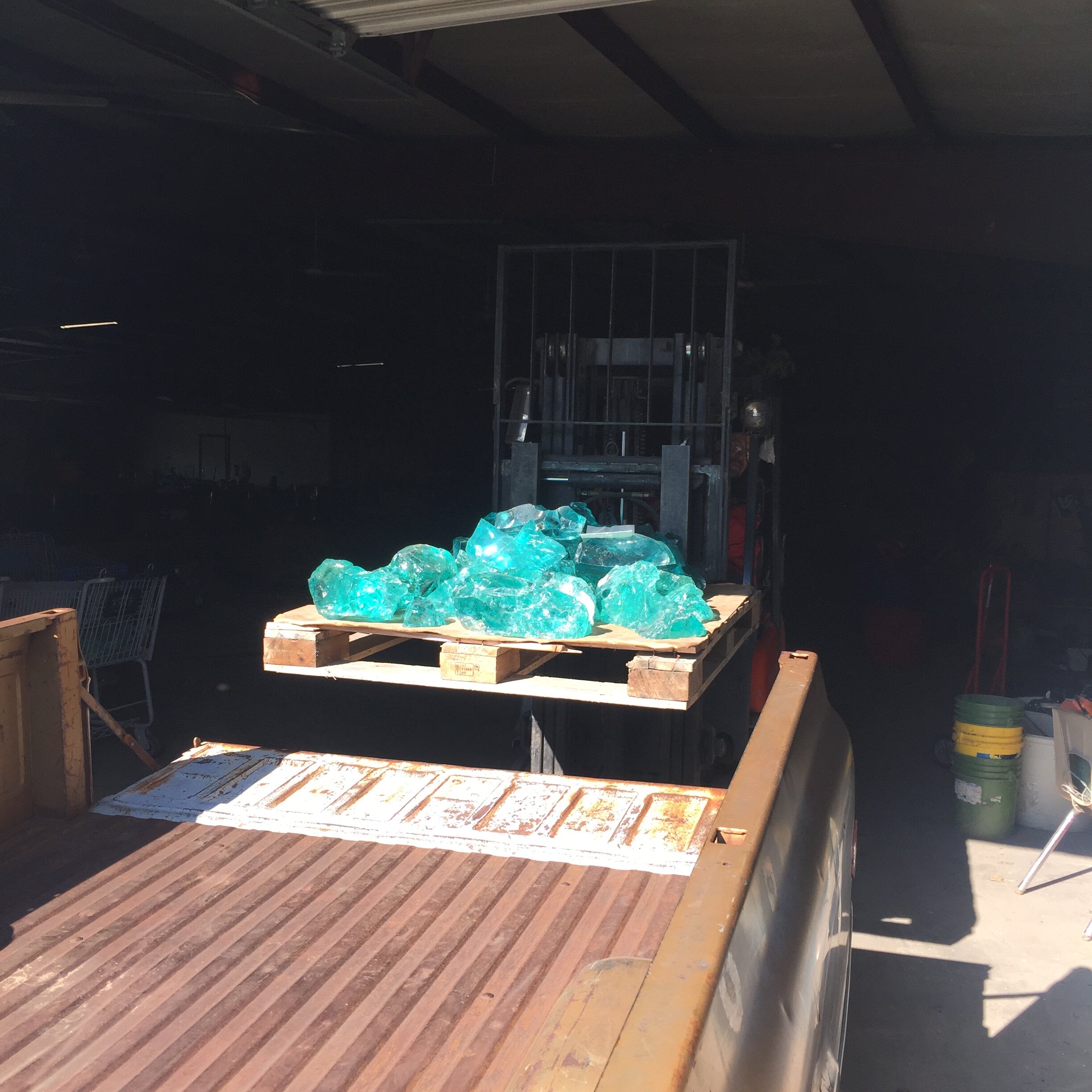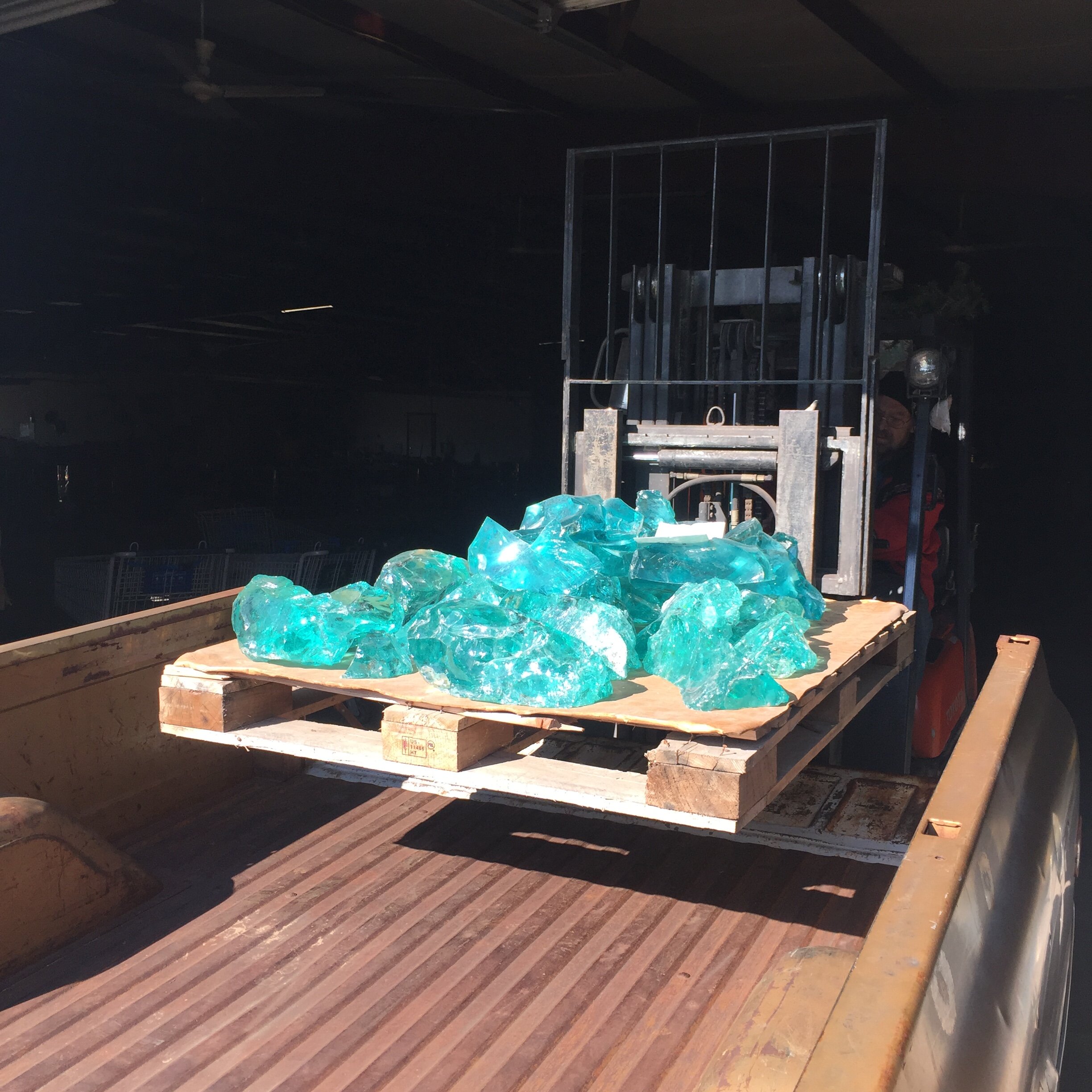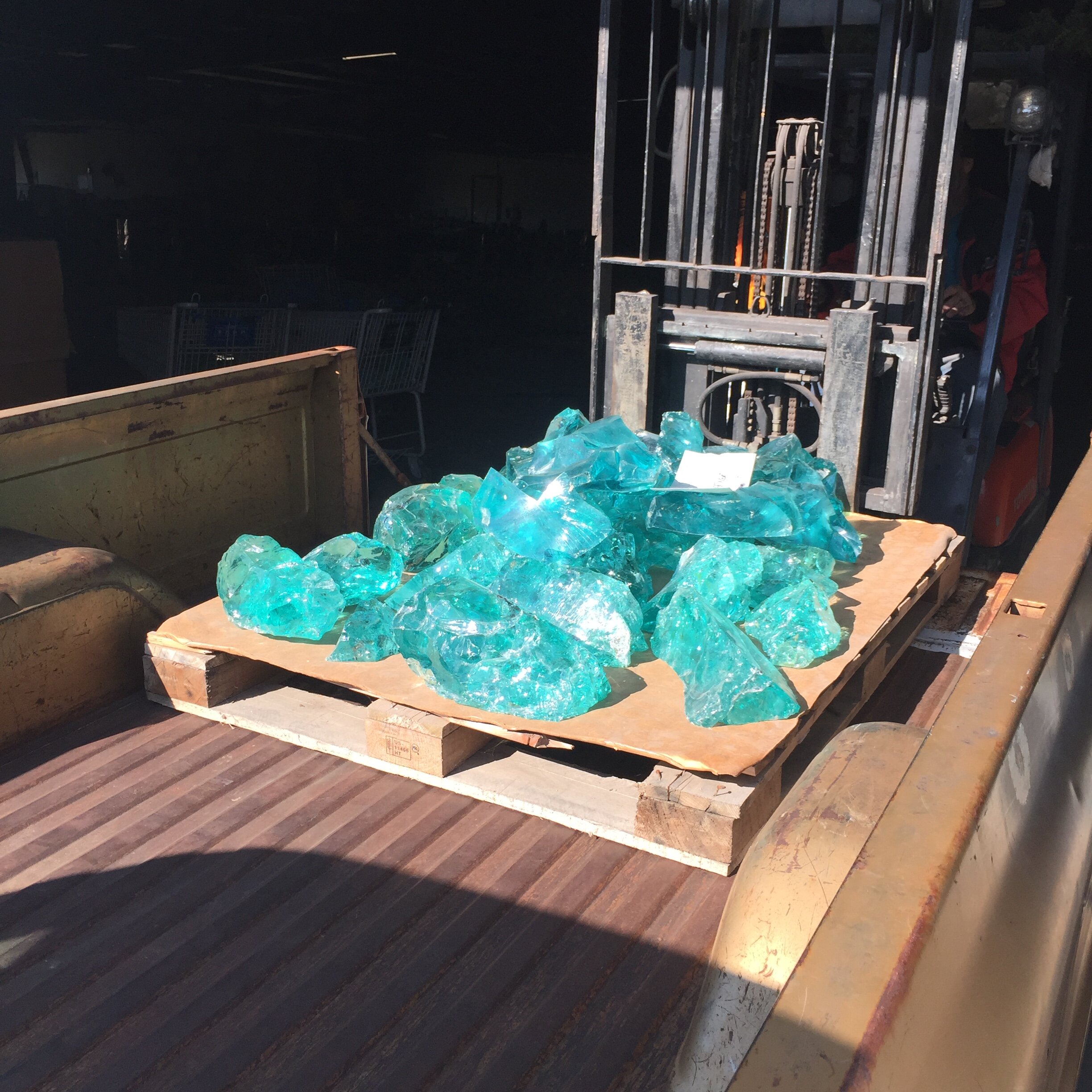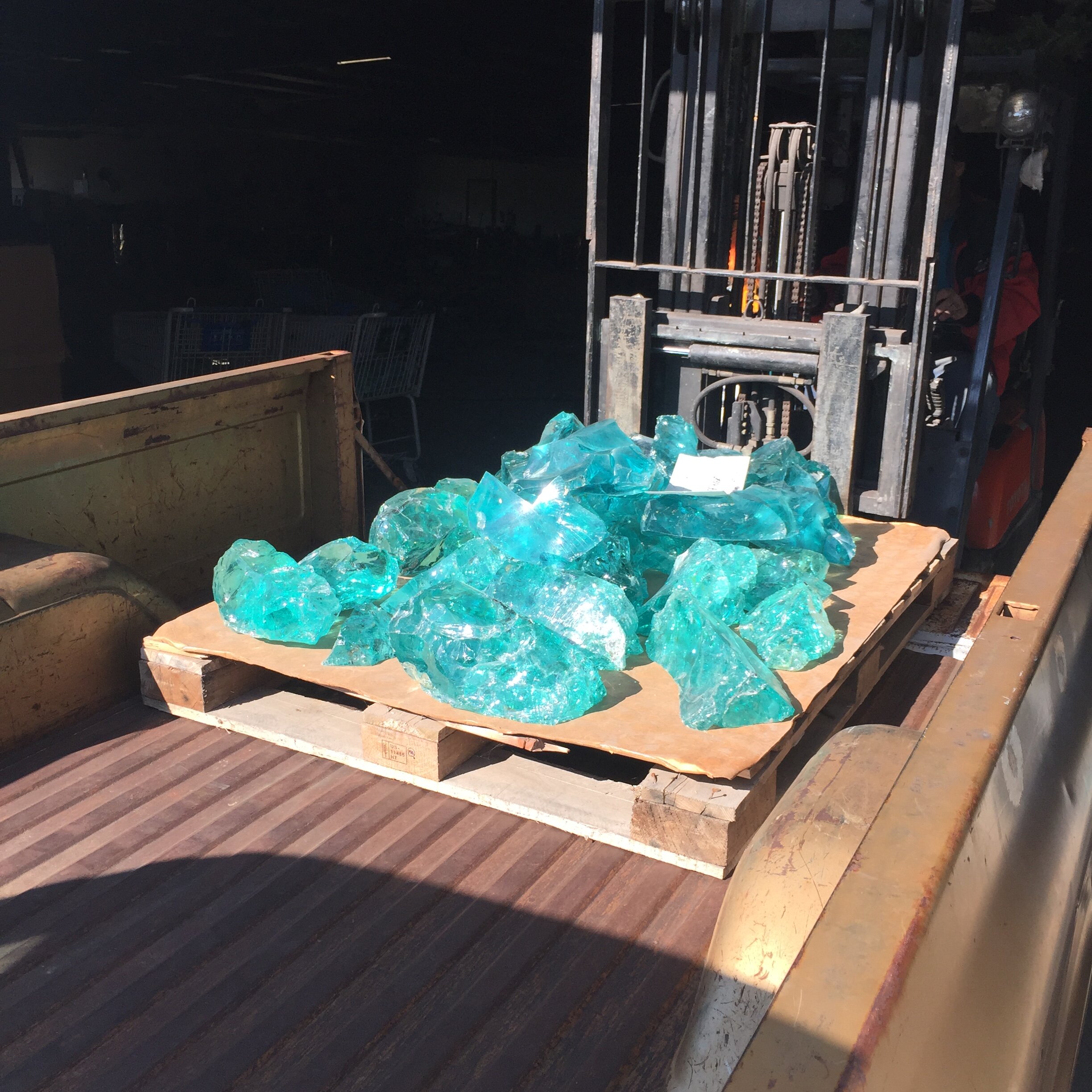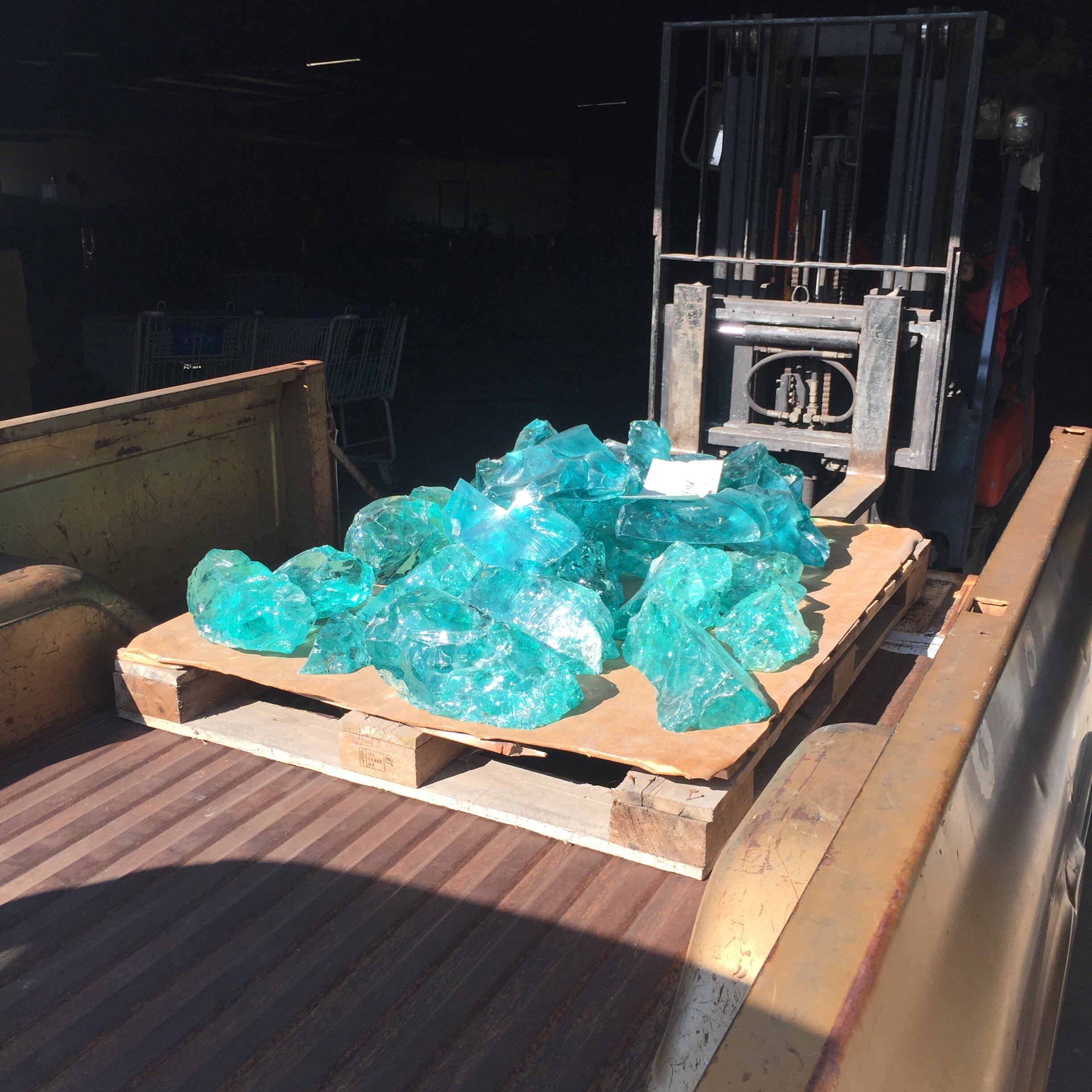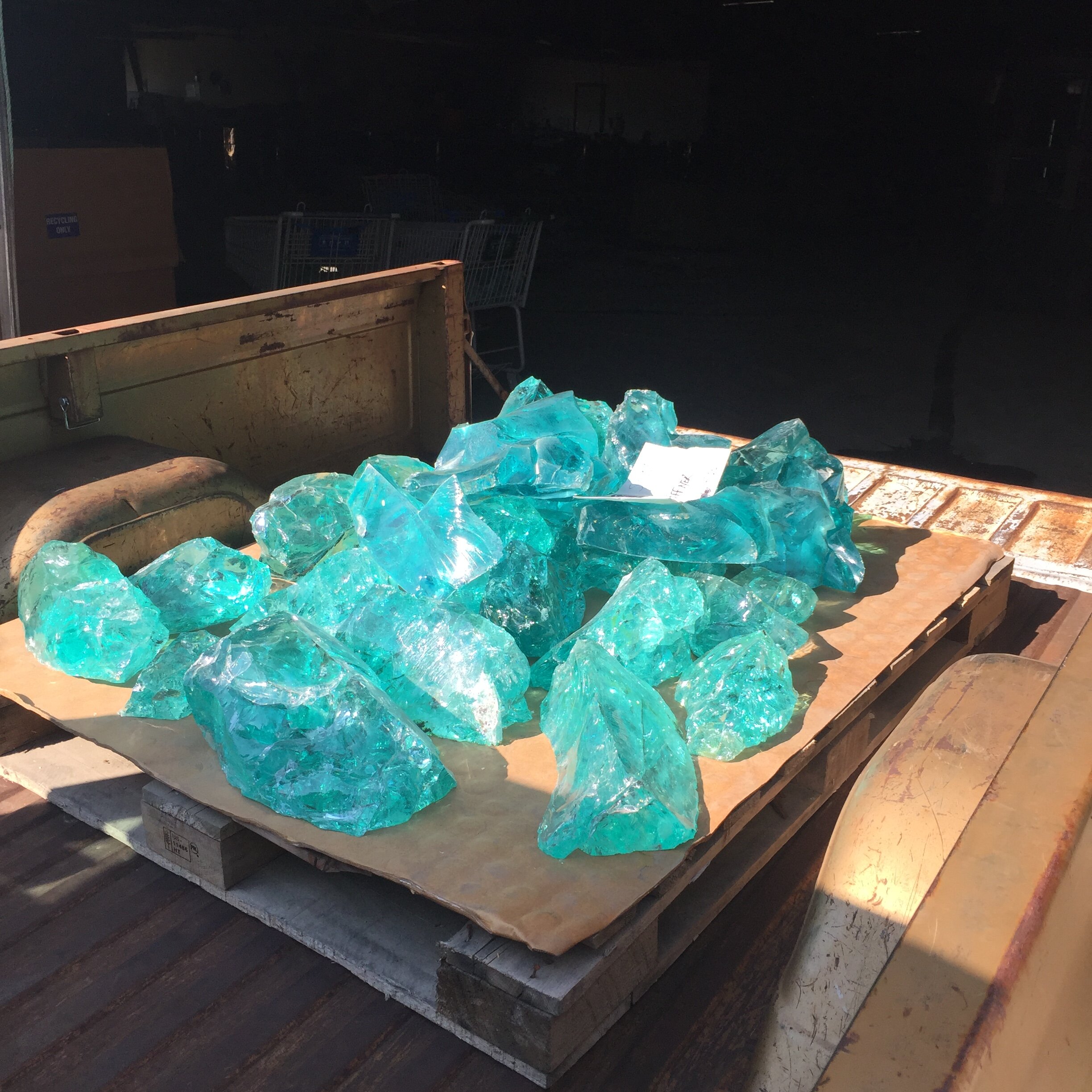ca. 2010 at Bruce Goff’s Bavinger House, Norman, Oklahoma, with a couple of chunks of glass cullet visible in the exterior wall.
Oklahoma architect Bruce Goff was affectionately known as “BG” to his students and friends. Another thing that could be described as BG is the signature icy Blue Glass that is familiar to Goff fans. Goff’s use of this material encapsulates the hallmarks of American School design, which are contextual, resourceful and experimental. The Bavinger House and Shin Enkan are just a couple of examples of projects where Goff specified the glass chunks which are variously known as slag glass and glass cullet.
A piece of glass cullet “liberated” from the storage room at Goff’s Shin Enkan, Bartlesville
When I was a student at the University of Oklahoma College of Architecture in the late 1980s, I was fortunate to be among a small group of students who went to Shin Enkan to help document some windows that needed restoration. As we were departing on one of our trips there, Professor Caldwell called us over to a storage room that was accessed from the exterior of the house and said something like, “Do you see that pile of glass cullet in this storage room? Well, no one is looking right now, but don’t be greedy.” I grabbed a couple cantaloupe-wedge sized pieces.
Fast forward about thirty years, and I’m on faculty at OU, and my research assignment is to design an exhibition that showcases works of faculty and students during and after the Bruce Goff era at the OU College of Architecture. The Bavinger House has now been destroyed by a mixture of extreme weather and insanity and there are rumors that the stone and cullet remains have been purchased by a Norman resident. Thoughts return to to the glass cullet and the remains of the Bavinger House which could be perhaps sanctified by somehow serving as an installation for the show. When the museum rightly brings up concerns of organic matter entering museum environment, thoughts focus on the cullet, and Goff’s original source in Henryetta, Oklahoma.
From the 1920s until 1976 when it was shut down, PPG ran a glass plant in Henryetta, Oklahoma. It produced a glass known as “Ice Blue.” This is the familiar color seen in Goff’s work around this region. The material was essentially free, because it was a waste product of the glass manufacturing process. Whenever the production line closed down for maintenance, change of color, etc., glass that remained in the kiln was allowed to cool and harden, then it was busted out and thrown away.
According to Gene Roberts [aka Henryetta Glassman], the main source of information in this blog, the slag or cullets accumulated into mountains of material outside the PPG plant and anyone who wanted some could haul it away for free. Clearly, Goff took advantage of this, checking the boxes for resourcefulness and arguably, contextuality. And because of the experimental nature of the material use and forms of Goff’s architecture, acquiring free material offset some of the cost of doing things that are not “normal.”
höffnerdesignstudio’s shop truck, a 1969 Chevrolet C-10, is affectionately known as “Golden Boy” and helps with the sorts of odd errands that can be necessary when an architecture firm has interests off the beaten path.
So join us while we take a trip to Henryetta to source the same glass that Goff used on some of his seminal projects.
With my dad, Lou, at his house at 9AM on 2019 12 12, getting ready to take off to Henryetta. We did our best to dress to blend in with the locals.
Dad will be 82 in a few weeks and he was understandably a bit apprehensive about riding in a 50 year old pickup truck 100 miles east to a small town in the middle of nowhere.
Dad remembering how to work a seatbelt in a vintage truck.
The ghost town of Boley, Oklahoma - image is from a 2011 visit.
Since the point was to entertain Dad, we took a scenic route along Highway 62 East. We made a surprise visit to the ghost town of Boley, an historic black town. It wasn’t practical to get out and walk around, so the photo included above is from a visit some years ago.
Dairy Boy in Okemah, Oklahoma.
The next surprise was also unexpected for me, as we encountered a “Dairy Boy.” Initially, the desire was to just stop and take a photo of the overly excited Dairy Boy, but with a little insistence, Dad agreed to indulging in a cone. [C’mon, how could you not?] Dad recognized the metal siding to be a product manufactured by his former employer, Star Buildings, manufacturer of pre-engineered metal buildings. Dad was an engineer doing practical research in the product development laboratory.
No regrets about getting a soft serve.
The view on US-75 north - Henryetta Glassman to the right, and the historic PPG Plant, now Anchor Glass can be seen beyond. Image from Google Maps.
We arrive in Henryetta and find our way to the Henryetta Glassman’s building. It is a powder blue steel building, dimly lit inside and surrounded by vehicles in various states of repair and little hills of broken glass. Off in the near distance, we can see what must have been the PPG plant back in the day.
There’s our material! 1,000 pounds [1/2 ton] of BG! They have kindly drawn our name complete with the umlaut.
Henryetta Glassman Gene Roberts explains to Dad how they have modified ceramic kilns to run hotter than normal to melt glass at 1900 degrees!
Dad examines some Pre-consumer waste material from Anchor Glass, made in the former PPG plant. Bottles are made with an injection molding process, and due to the production differences between that and float glass, there is no “slag” waste produced. The waste material here is bottles that have flaws and cannot be sold.
PPG left Henryetta in 1976 and the “Ice Blue” glass familiar to fans of Bruce Goff was gone - no longer produced. What wasn’t hauled away for free by opportunists like Goff was buried at various properties around town, presumably as fill material or perhaps with a modest disposal fee paid by PPG to the local farmers. Occasionally, someone still runs into a vein of the material on their property and word gets back to the Glassman.
When I first contacted him about the project, he said the Ice Blue color was essentially all gone, but he had some information about where he might be able to “dig some up.” At the time, I didn’t realize that he literally would be digging it out of the ground, where it had been dumped and covered up 40+ years ago.
The other interesting tidbit was that cullet or slag really isn’t thrown away anymore, because modern kilns don’t mind if pre-consumer waste is recycled by melting it back into the production line. That, coupled with the fact that “Ice Blue” simply isn’t manufactured anymore, plus the hassle of extracting what might turn up buried in the future, means that höffnerdesignstudio’s 1,000 pound haul could very well be the last of its kind. So whether this ends up being some kind of collateral to the RENEGADES exhibit at OU, or saved for a future höffnerdesignstudio project, we have our hands on some rare material - what we in the vintage motorcycle and car hobby like to call “unobtainium.”
After our chat with the Henryetta Glassman, we loaded up. Theoretically, we were maxxed out with our 1,000 pound load, because Golden Boy is a 1/2 ton pickup. He’s also a 1/2 century old, but he is a trooper.
1/2 century old 1/2 ton pickup with 1/2 ton of Ice Blue glass cullet.
Other interesting colors and formulations abound. This one was made from amber glass, like beer bottles, and when the glass is so thick it become practically black.
A surreal landscape of broken glass surrounds the building.
Before we left, we asked about eating locally - it was lunch time. Gene confirmed professor Boeck’s report that the BBQ place across US-75 is good, and that there is another locally owned joint called “Classic Diner” on the historic Main Street. Dad refused to pick, so “Rustler’s BBQ” was it. We forgot to photograph the dining experience - I’d say the food was good and the aesthetics were what you would expect of a BBQ joint.
Dad and I talked about a range of topics as we had our lunch and he waxed philosophical about taking the opportunities that life presents while one possesses the health and joie de vivre to do so. Sage advice, so we decided to take an alternate route back home, exploring highway 270 west.
As we drove from small town to small town, Dad lamented the material loss and human suffering represented by the old buildings and houses in poor repair, yet neither of us could deny the odd beauty that comes along with the decay of old structures. A second ghost town, Earlsboro, presented itself along the way home. We stopped to take this picture, and with Dad waving, seems to be a suitable parting shot.
Learn more about the Henryetta Glassman.










![There’s our material! 1,000 pounds [1/2 ton] of BG! They have kindly drawn our name complete with the umlaut.](https://images.squarespace-cdn.com/content/v1/568e986ae0327cef88802145/1576293419992-L78LDDVURCYTUSROEHX6/IMG_2507.JPG)


